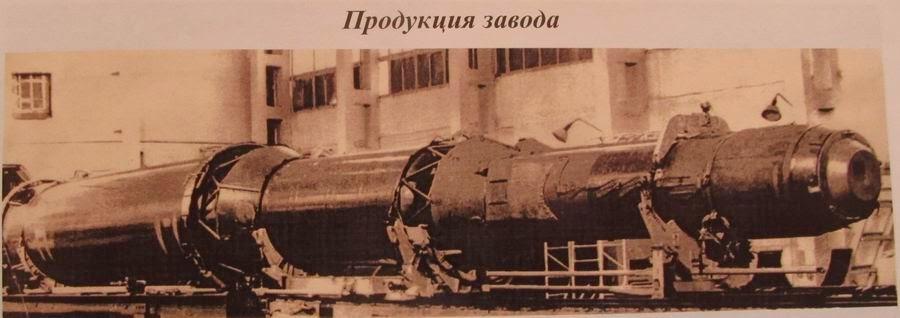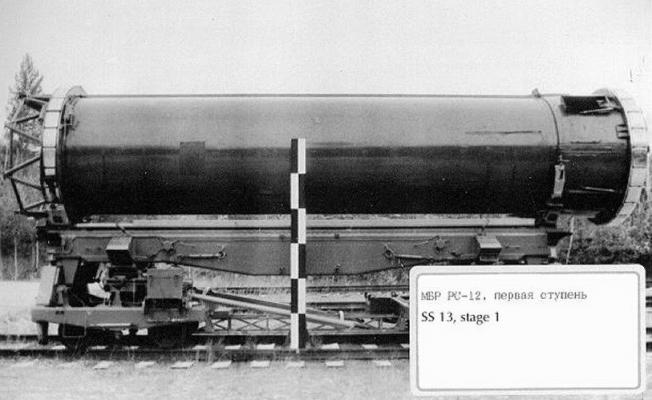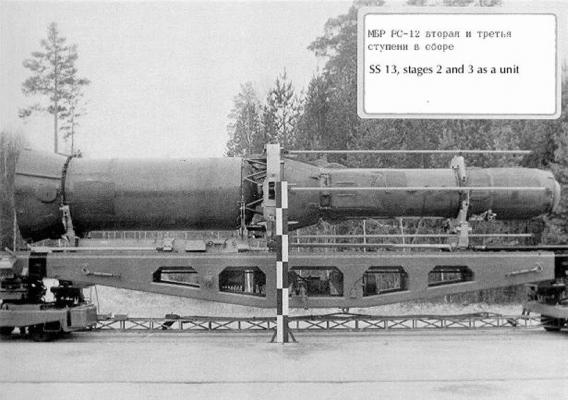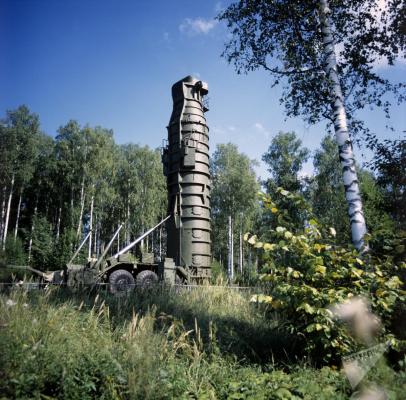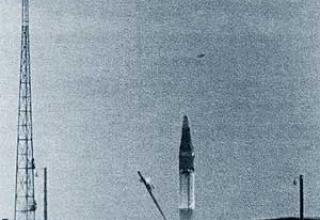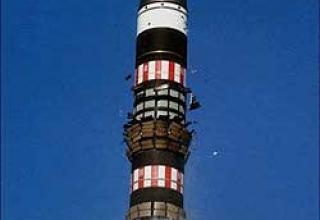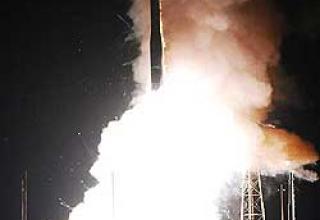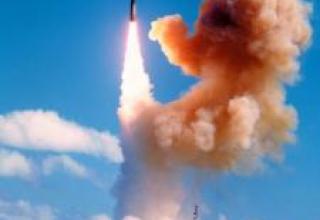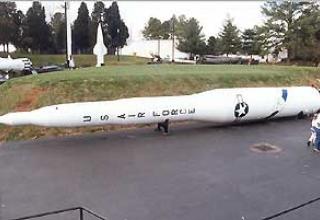The 15P098 Battle Rocket System (BRK) is the first Russian strategic system equipped with the RT-2 (8K98) solid-fuel intercontinental ballistic missile. The development of the RT-2 (8K98) three-stage solid-fuel ICBM was started at the Design Bureau-1 under the leadership of S.P.Korolev in accordance with the USSR Government Resolution of April 4, 1961. The leading designer was I.N.Sadovsky, Deputy Chief Designer of OKB-1. The engines of the first and third stages were developed at the Perm Machine Building Design Bureau, the engine of the second stage - at the Leningrad Central Design Bureau-7. The first and second stage engines were developed by the Altai Research Institute of KhT, the third stage engine was charged by the Perm Research Institute-130 (Research Institute of Polymeric Materials). The single-start mine launcher (SPU "OS") and the command post were designed in the TsKB-34 (Special Machine Building Design Bureau, Leningrad) under the leadership of V.V.Chernetsky and E.G.Rudyak. The Autonomous Inertial Control System was developed at the Research Institute of APS under the leadership of Nikolai Pilyugin. The remote start control system was developed at the Experimental Design Bureau "Impulse" under the supervision of Taras Sokolov. Series production was launched in 1966 at the Perm Machine Building Plant named after V.I.Lenin, in 1967 production was continued at the Perm Chemical Equipment Plant (PZHO).
Tests were held from February 5, 1966 to October 3, 1968 at the Kapustin Yar and Plesetsk test grounds. In the course of the State Flight Tests 17 single launches were carried out with the ballistic missile control system, and for the first time 3 single and one triple rocket volley were produced (on August 28, 1968) with the UPC GSh. Initially, development of the on-duty mode began with one command post (KP) and three launchers, later the number of launchers was brought up to 10. By the Decree of the CPSU Central Committee and the Council of Ministers of the USSR No.1004-3 of December 13, 1968 the CDB 15P098 was adopted for service with the Soviet Army. By 1971, 60 serial launchers consisting of 6 BRK 15P098 were built near Yoshkar-Ola.
This missile was the first solid-propellant ICBM to be adopted by an early-warning missile and was essentially a transition from second to third-generation missiles. Important features of the 15P098 complex were ease of operation, high technical readiness of the missiles, a relatively small number of service units, and no refueling facilities. At the same time, the RT-2 ICBM was significantly inferior in a number of parameters to the American Minuteman-2, which was created approximately in the same years.
The Decree of the CPSU Central Committee and the USSR CM of December 18, 1968 set the modernization of missile 8K98 as part of the complex 15P098. The upgraded complex received the index 15PO98P, the missile - 8K98P . The missile was developed at the Central Design Bureau-7 under the leadership of Peter Tyurin. State testing of this complex began in December 1969 and ended on January 14, 1972 with the production of 15 launches (13 of them were successful). Between 1974 and 1982, mass production of 8K98P missiles was launched.
From the time of adoption for service and until 1987 inclusive missiles were undergoing postwarranty operation under various research programs of the Ministry of Defense of the USSR. The programs ended with flight launches of missiles from the Plesetsk test site. The launches invariably confirmed the high reliability of the missile, including the service life from 15 to 17 years.
By the time the START-1 Treaty was signed in 1991 (under this Treaty, the missile is designated RS-12) there were 40 RT-2P on combat duty. In fulfillment of the Soviet Union's obligations under the Treaty, the 15PO98P combat missile system was included in the list of decommissioned missiles and was completely eliminated in the period from 1992 to 1995.
The 15P098P and 15P098P complexes were designated by NATO as SS-13 "Savage" mod1 and mod2, respectively.
Composition:
The RT-2 missile (see layout chart) had three marching steps. Connecting compartments of the enzyme structure were used for joining the steps with each other, allowing gases from running engines to escape freely at "fire" separation of the steps. Between the third stage of the rocket and the head end there were an instrument compartment and an adapter designed for fixing the GC. All RDTs were made in different diameters (see photo), the rocket engine nozzle blocks had four cut control nozzles each, consisting of fixed and movable parts. It was envisaged to create missiles at intermediate ranges by combining the stages of RT-2 rocket. The missile was equipped with a monoblock nuclear detachable in flight head part with a thermonuclear charge with a capacity of 600ct.
The RDTT first (15D23) and second (15D24) marching engines had the same design scheme and consisted of steel cylindrical bodies with elliptical rear and front heads.
The front heads were equipped with solid fuel charge ignitors. RDTT charges were made of mixed fuel based on butyl rubber and ammonium perchlorate with the addition of powdered aluminum. Nozzle blocks, steering actuators and part of the control system were placed in the tail compartments of steps, which had the shape of a truncated cone. To increase the missile's stability at the initial stage of flight, four grating stabilizers were installed in the tail compartment of the first stage.
The third stage was similar to the first two, but had differences in the design of the hull and charge of the RDTT, the tail compartment. In addition, the engine of this stage - 15D25 had thrust cut-off devices.
The missile was equipped with an inertial control system that controlled the missile's flight from the moment of launch until the transition to the uncontrolled flight of the head end. The control system was equipped with counting and resolution devices. Most of the control devices were placed in the instrument compartment.
All parameters of RT-2 rocket (fuel distribution between stages, diameter of engines, time of their operation, pressure in combustion chambers and on nozzle cut, etc.) were chosen close to optimal. Still, RT-2 missile required further improvement. Thus, the mixed fuel was formed in separate molds, then the charge was put into the body, and the gap between the charge and the body was filled with binder - this created certain difficulties in the manufacture of RTDT rocket.
The missiles were placed in the "OS" type control gear, connected to each other by power supply, combat control, data transmission and communication lines. Control of the technical condition and the launch were carried out remotely by commands from the unified command post 15U52, developed in the KBSM under the guidance of Chief Designer E.G. Rudyak. Quite comfortable conditions were created at the command post for the combat calculations, which were on duty, taking into account the latest ergonomic requirements. The DBK consisted of 10 launchers.
Launching unit 15P798 (see layout diagram) consisting of: equipment of special construction 15U7, protective device 15U9 and damping device of sighting system hydrostabilizer (direction keeper) 15U43 were developed in KBSM.
The missile, having obturating belts, leaned without a gap on the starting cup with a deaf bottom and was launched on its own marching engine.
The first stage was delivered to the combat launch position in a container separately and the second and third stages of the missile were separately docked. This complex was the first to adopt and implement the method of craneless reloading of the rocket in all operations conducted with it in military units and at the test site, which has fully justified itself by ensuring the safety of transshipment work.
The ground equipment of the complex included (designer of Motor Design Bureau, chief designer V.A.Rozhdov):
- transport and loading machines (TZM) 15U39 and 15U40 for receiving (issuing) rocket blocks from isothermal railway wagons or docking bogies, transporting blocks within the position area and block loading (unloading) of the rocket into the launch facility. TZM are made on the basis of MAZ-537E tractor with semi-trailer on the activated stroke (see photo);
- isothermal docking machine 15T21, designed to transport the head units within the position area and docking them to the missile in the launcher;
- docking trolleys for work with the missile in the inspection body ;
- a railway isothermal wagon with a retractable frame for block transportation of the missile from the manufacturer's plant to the position area (designer of the Kalininsky Carriage Works SKB, chief designer L.D. Novikov).
- Regular vehicles for various systems of the complex based on the Ural 375 high cross-country ability vehicle.
Many new promising technical solutions were introduced in the design of the 15P798 launcher. One of the most difficult technological tasks was the task of creating the starting glass for mass production. Since the missile rested on the inner surface of the cup with its roughing surfaces, it was necessary to ensure the accuracy of the inner diameter of the cup not lower than class 5 (on the cup with the length of 22400 mm and diameter of 2208 mm it was necessary to ensure the internal diameter tolerance equal to 2.5 mm). In the manufacture of steel beaker for the experimental start-up SM-170A and 3 glasses 15U7 it became clear that to ensure these requirements on the beaker can only be achieved by labor-intensive manual finishing operations of the inner surface of the beaker in places of welded joints. Therefore, GRP was chosen as the construction material for the glass. The glass was manufactured by winding, which immediately solved the problem of ensuring the accuracy of its inner surface. To solve technological issues in fiberglass plastics and manufacture of prototypes, a specialized organization - SPKB (Khotkovo, Moscow region) was involved. Series production of starting glasses was organized at "Plastmass" plant in Safonovo, Smolensk region. A special workshop with the area of 40 hectares was built at the plant, where winding production, furnaces for polymerization of products, as well as production for processing finished products made of fiberglass (processing of ends and joints, holes and other operations) were placed. A separate workshop was built for preparatory operations - impregnation of fabrics with epoxy resin before winding. With the commissioning of the plant the issue of supply of fiberglass glasses was resolved cardinally. Later on, this production was used for winding of motor hulls, manufacturing of TPK for other complexes, including ship starter units. By creating the glass-fiberglass beaker it was possible to unload the machine-building plants, by transferring orders to the chemical industry, to reduce the labor and metal intensity of production, to reduce the weight of the construction almost in 2 times, as well as to exclude temperature stresses affecting the strength of the glass.
According to the TTT, on which the complex 15P098 was created, it was planned to reduce by an order of time its combat readiness in comparison with the complexes of the first generation. Of all ground equipment involved in the launch, the opening time of the protective device (protective roof of the launcher) was critical. Protective devices of the launchers used on the first generation complexes had two-stroke electric or electro-hydraulic drives and could not ensure the performance of the TTT in time due to the lack of required capacities (in the mode of autonomy the PU was powered by batteries). In addition, the location of the roof drives required an increase in the area of the building structure's casing, which increased the load on the barrel from a nuclear explosion and created additional problems for the missile's depreciation.
The solution was proposed and then implemented by V.S.Ushakov, who proposed to create a fundamentally new protective device of inertial type with a single-stroke powder engine, with a minimum consumption of electricity, which goes only on the use of firepower. Roof lifting required to break off the seals was carried out at the initial section of the roof movement by copying sections of the rail track. The efficiency of the created protective device was as follows: a seven kilogram charge of NMF-2 powder provided opening of the roof weighing 40 tons in 0.3 seconds. Guaranteed reliability of the protective device is provided by tripling the means of initiation of the gunpowder charge. A thorough bench testing of the protective roof was conducted. The tests reproduced ground and tree piles, freezing and snow drifts, which the protective device could easily overcome. In the process of LKI and more than twenty years of operation of the complex failures of the protective device were not observed.
To ensure the safety of the missile from a nuclear explosion, a pendulum shock absorber with springs and hydraulic dampers was used on the launcher for the first time. During launches, vertical damping was stopped by special devices in hydraulic dampers, while horizontal damping was not stopped. For the first time, an automatic sighting system with a gyroscopic direction guard was used in the starter unit. To ensure its safety, a pendulum damping system with air damping was created, which provides very low overloads of the direction guard, high accuracy of its return after oscillations to the initial position and low damping time.
At creation of the improved BRK 15P098P the object of modernization became a rocket and equipment of the complex in part:
- converting all rocket engines to a single blended solid fuel;
- introduction of a set of means to overcome missile defense;
- modernization of the control system, which provided storage of two flight missions with remote selection of one of them;
- expanding the firing sector without increasing prelaunch preparation time;
- increased range and accuracy;
- taking technical decisions to eliminate unauthorized missile launches;
- improvement of the 15U7M launcher.
RT-2P missile is similar to RT-2 in its dimensional and geometrical characteristics, but in terms of tactical and technical data it considerably exceeds the latter.
Modernized RT-2P (see diagram) carried a monoblock head end with a thermonuclear charge of 750ct. It was also possible to install splitting (up to eight) head parts. The complex of means of overcoming the enemy's "Birch" anti-missile defense, providing in the flight of radar camouflage and distortion of radar characteristics, programmed withdrawal of the spent third stage of the missile, the release of numerous combined false targets, was developed at CNIRTI under the leadership of Vitaly Gerasimenko.
The RT-2P rocket was equipped with a mixture of solid fuel based on butyl rubber with high plasticity, with no noticeable aging and cracking during storage. This fuel was poured immediately into the engine body, then polymerization and formation of necessary charge combustion surfaces were performed.
Characteristics:
| General characteristics of BR | ||
| Parameter | 8К98 | 8K98P |
| Range of fire, km | 9600 | 10000-10200 |
| Shooting accuracy (CWO), m | 1800-2000 | 1500 |
| Charge power HF, kt. | 600 | 750 |
| Weight of the head end, kg | 500-600 | 466-470 |
| The length of the rocket, m | 21.27 | 21.265 |
| The length of the missile without the head end, m. | 18.2 | 19.66-19.7 |
| Maximum housing diameter, m | 1.84 | 1.84 |
| Diameter of stabilizers, m | 3.618 | 3.618 |
| Start mass, t | 46.1-51.0 | 51.9 |
| Maximum speed, m/s | 7030 | - |
| Maximum height of the trajectory, km | 1310 | - |
| First step | ||
| length, m | 8.7 | 9.2 |
| diameter, m | 1.8 | 1.84 |
| step weight, t | 34.5 | 34.55 |
| fuel weight, t | - | 30.67-30.8 |
| Working time, s | 75 | 75.4 |
| Pulling, shh. | 91 | 100 |
| Pressure in the combustion chamber, kgf/cm2 | 40 | 56 |
| Second step | ||
| length, m | 4.74 | 5.08 |
| diameter, m | 1.48 | 1.49 |
| step weight, t | 9.6 | 11.28 |
| charge weight, t | - | 9.78 |
| Working time, s | 60 | 60.6 |
| Pulling, shh. | 44 | 44-44.6 |
| Pressure in the combustion chamber, kgf/cm2 | 40 | 48 |
| Third step | ||
| length, m | 3.827 | 5.45 |
| diameter, m | 0.98/1.06 | 1.0 |
| step weight, t | 3.5 | 4.64 |
| fuel weight, t | - | 3.6 |
| It's work time, s | 45-46 | 49 |
| Pulling, shh. | 22 | 18 |
| Pressure in the combustion chamber, kgf/cm2 | - | 48 |
Testing:
Flight tests of the rocket RT-23UTTH (15Zh61 ) were conducted from February 27, 1985 to December 22, 1987 in NIIP-53 (Mirny), a total of 32 launches were made. There were 18 launches of the train for resource and transport tests, during which more than 400 thousand kilometres were covered by the country's railways. The tests were conducted in various climatic zones from Salekhard in the north to Chardzhou in the south, from Cherepovets in the west to Chita in the east.
In 1988 at the Semipalatinsk test site special tests of BZHRK on exposure to electromagnetic radiation ("Shining") and lightning protection ("Thunderstorm") were successfully conducted. In 1991 on NIIP-53 there was carried out an inspection on the impact of a shock wave ("Shift"). Two launchers and a command post were tested. The objects of testing were located: one (PP with the loaded in it electromagnetic missile, as well as the control room) - at a distance of 850m from the center of the explosion, the other (second PP) - at a distance of 450m face to the center of the explosion. The impact wave with a TNT equivalent of 1000 t did not affect the performance of the missile and the boost-phase control.
The first missile regiment with RT-23UTTH rocket went on duty on October 20, 1987 (Kostroma, commander V.Yu. Spiridonov). By mid-1988, 6-7 regiments had been deployed (a total of about 20 PU, all under Kostroma). By 1999, deployed three missile divisions, armed with BZHRK and RT-23UTTH ICBMs (near Kostroma, Zvezdny village near Perm and Kedrovy village in the Krasnoyarsk Territory), each of which has four missile regiments. The compositions were at a distance of about four kilometers from each other in stationary structures. As the compositions began to take up combat duty, they were dispersed (see photo).
When moving along the country's railway network, the BZHRK made it possible to quickly change the location of the starting position to 1000 kilometres per day.
Sources:
- "КБ специального машиностроения: От артиллерийских систем до стартовых комплексов" (под редакцией Ушакова В.С.) .СПб, 2004.
- Карпенко А.В., Уткин А.Ф., Попов А.Д. "Отечественные стратегические ракетные комплексы". СПб, Невский бастион-Гангут 1999 год.
- Первов М.А. "Межконтинентальные баллистические ракеты СССР и России"
- Ракета РТ-2П / РКК "ЭНЕРГИЯ" /
- Межконтинентальная баллистическая ракета РТ-2 (8К98) / РТ-2П (8К98П)
- РТ-2 8К98 (РС-12) /"Капустин яр"/
- RT-2 - SS-13 SAVAGE /"Federation American Scientists"/
- Народный музей истории завода АО "Мотовилихинские заводы" Пермь, 2004 год /"Вестник ПВО"/

